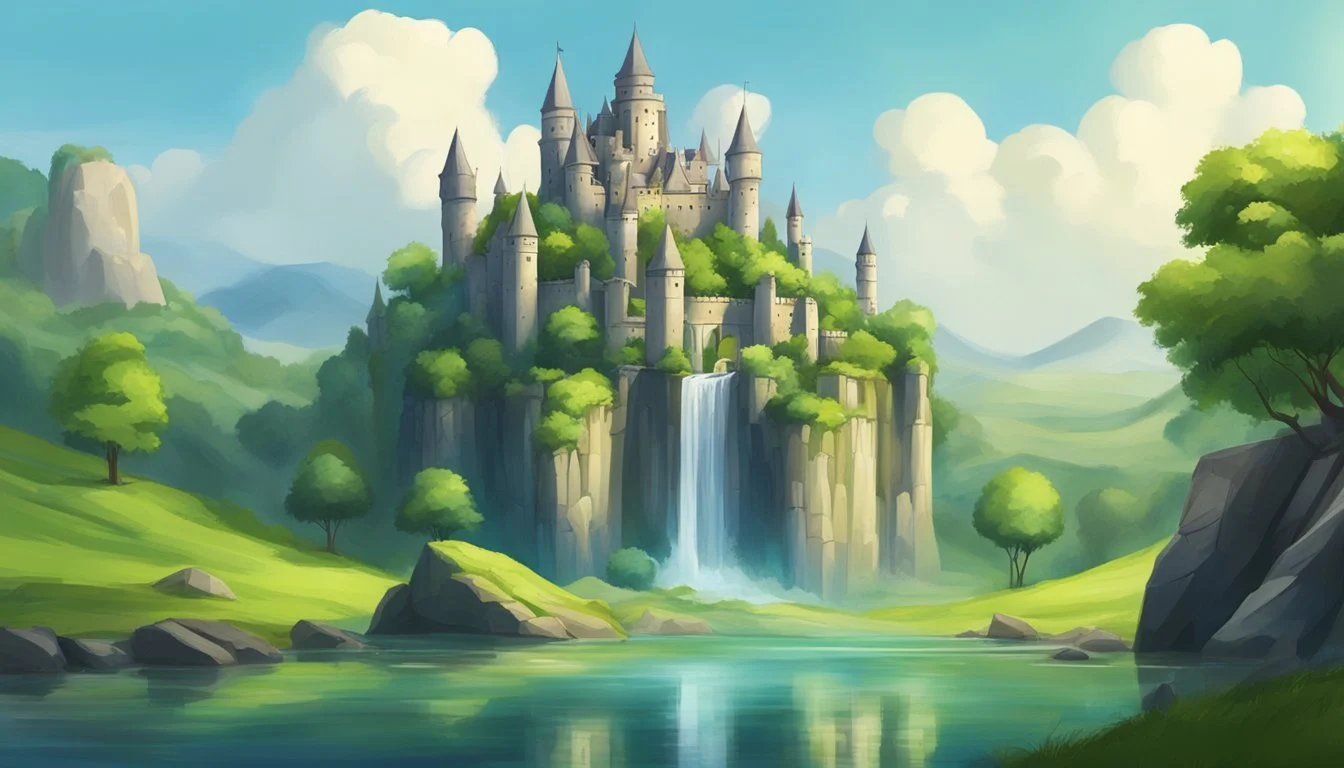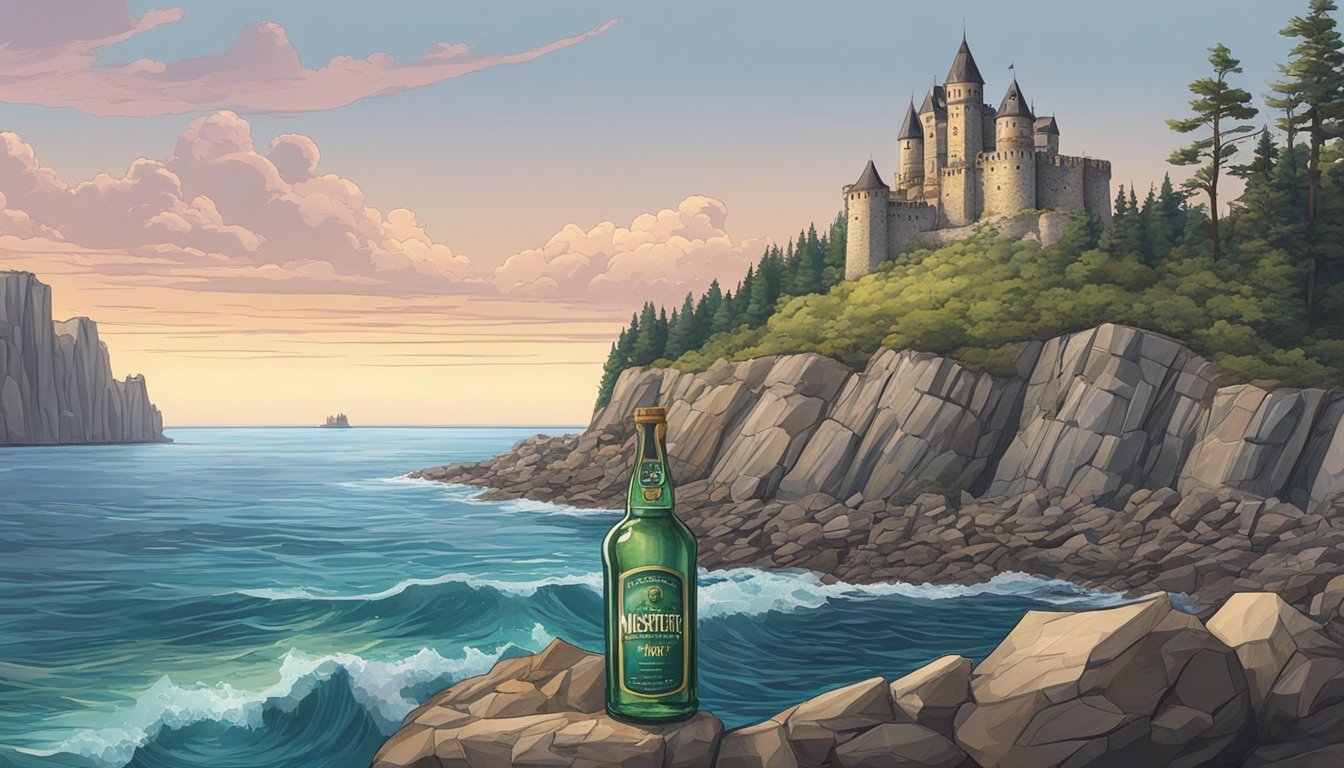Castle Rock vs. Weird Water
A Comprehensive Bottled Water Comparison
The choice between Castle Rock and Weird Water bottled water brands often comes down to a matter of taste and quality. Castle Rock, sourced from pristine springs, offers a crisp and refreshing experience that many consumers find superior. By contrast, Weird Water's unique marketing might appeal to a younger audience, yet its flavor profile tends to polarize opinions.
For those seeking a premium option with a reliable reputation, Castle Rock stands out as the better choice. Its light and clean taste, combined with its minimalist mineral content, makes it a favorite among bottled water enthusiasts. Weird Water, while interesting in its branding, trails behind in taste tests and overall satisfaction.
Engaging with both brands reveals stark differences in consumer preferences. Castle Rock exudes reliability and purity, perfect for those who value a straightforward hydration solution. Meanwhile, Weird Water’s quirky appeal may intrigue some, but often falls short in delivering a consistently refreshing experience. This comparison aims at helping readers make an informed decision on their next bottled water purchase.
Understanding Bottled Water
The bottled water industry has grown significantly, offering various types of water to meet consumer preferences and needs. The quality of bottled water can vary, making it important to understand its sources and characteristics.
History and Growth of Bottled Water
The history of bottled water dates back to ancient civilizations where it was collected and stored for health benefits. The 18th and 19th centuries saw the commercialization of bottled water, with European spas being popular sources. In the late 20th century, the preference for bottled water surged due to concerns over tap water safety and convenience.
Today, bottled water represents a significant segment of the beverage market. This industry continually evolves with a focus on environmental sustainability and innovative packaging, including the use of environmentally friendly materials.
Types of Bottled Water
Spring Water: Sourced from natural springs, such as the water from Castle Rock, this type often undergoes minimal processing to maintain its natural composition.
Purified Water: Tap water that has been filtered and processed to remove impurities. It's often marketed for its purity and clean taste.
Mineral Water: Contains naturally occurring minerals, making it distinct in flavor and sometimes in health benefits.
Artesian Water: Comes from a confined aquifer where water flows naturally to the surface. This type is valued for its purity and elevated mineral content.
Each type of bottled water has unique characteristics and advantages, appealing to different consumer preferences.
Evaluating Water Quality
Quality assessment of bottled water involves several factors, including source, purification processes, and mineral content. For example, Castle Rock water, which is sourced from the springs of Mount Shasta, boasts a natural filtration process through granite and volcanic tubes.
Nutrition labels often detail serving sizes and mineral content, aiding in transparency for consumers. Environmental factors, such as bottle material, also play a significant role. Brands using eco-friendly packaging, such as glass bottles, emphasize sustainability.
Consumer Reports and blind taste tests offer insights into taste and preference, with some brands ranking higher based on flavor and texture. Consumers should consider both taste and quality metrics when choosing bottled water.
Castle Rock: Unveiling the Brand
Castle Rock Water stands out due to its unique origin in California, meticulous production process, and commitment to environmentally friendly practices.
Origin and Source
Castle Rock Water originates from the pristine springs of Mount Shasta's glacier. Found in Dunsmuir, CA, this spring water is naturally filtered through layers of granite and gem-infused rock. This lengthy natural filtration process ensures a pure, crisp flavor reminiscent of a fresh morning hike. The water is celebrated for maintaining its natural characteristics, reflecting the untouched nature of its source. As such, Castle Rock taps into a genuinely authentic and natural water supply.
Production Process
The production process of Castle Rock Water is designed to preserve the water's natural purity and taste. Once the water emerges from Mount Shasta’s springs, it undergoes minimal processing. This approach maintains the water's natural mineral content and clean taste. The bottling process also includes the use of 55% recycled glass, underlining the brand's commitment to sustainability. By prioritizing the natural composition of the water, Castle Rock ensures each bottle delivers water as nature intended.
Environmental Practices
Castle Rock Water takes significant steps to minimize its environmental impact. The brand uses recycled glass in its bottling process to reduce plastic waste. Additionally, Castle Rock commits to sourcing water sustainably, ensuring the local ecosystem around Mount Shasta is not adversely affected. These practices highlight Castle Rock's dedication to producing natural water while being mindful of environmental conservation. By integrating sustainable practices, Castle Rock balances delivering high-quality water with protecting the environment.
Comparing Bottle Materials
Understanding the differences between glass and plastic bottles is key when choosing the best bottled water. This section explores how bottle material impacts the environment and consumer preferences.
Glass vs. Plastic Bottles
Glass bottles, such as those used by Castle Rock Water, are often preferred for their environmental benefits and taste preservation. Glass is a non-reactive material, meaning it won't leach chemicals into the water, which can happen with some plastic bottles, like those used by Aquafina and Dasani. This quality makes glass ideal for maintaining the purity and flavor of the water.
Plastic bottles are lightweight and shatterproof, making them convenient for on-the-go consumption. Brands such as Aquafina and Dasani favor plastic for its durability and cost-effectiveness. However, not all plastic bottles are created equal; some may contain BPA, a chemical linked to health concerns.
Environmental Impacts
Glass bottles are more sustainable as they are often made from recycled materials and are fully recyclable themselves. Castle Rock Water, for instance, uses environmentally friendly glass for their bottles. Producing glass requires more energy, but its long-term recyclability and non-toxicity balance out this initial energy cost.
Plastic bottles contribute significantly to environmental pollution. Although many are recyclable, a large proportion ends up in landfills and oceans due to improper disposal. Despite efforts by some companies, like Boxed Water, to use more sustainable materials, the environmental drawbacks of plastic persist. Recycling rates for plastic bottles are also lower compared to glass.
Consumer Preferences
Consumers often favor glass bottles for the perceived purity and taste of the water. Glass’s non-reactive nature means it doesn't affect the water's flavor, which many find appealing. Castle Rock Water, sold in glass, tends to be preferred by consumers who prioritize taste and environmental friendliness.
Plastic bottles remain popular for their convenience. Brands like Aquafina and Dasani benefit from the portability and durability of plastic. Consumers who prioritize convenience and cost often prefer plastic bottles. Boxed Water offers a middle ground with its carton-based packaging, appealing to environmentally conscious consumers looking for an alternative to traditional plastic and glass options.
Taste Profiles of Bottled Water
The taste of bottled water can vary significantly due to multiple factors, including mineral content and the source of the water. Insights from water sommeliers can also help highlight the nuances in taste profiles.
Factors Affecting Water Taste
Water Source and Treatment: The origin of the water and the treatment process it undergoes play a crucial role. Spring waters often have a cleaner, more natural taste, while treated municipal sources might retain hints of chemicals like chlorine.
Packaging: The type of container can also affect taste. Plastics sometimes impart a slight flavor that can be off-putting, whereas glass containers generally don't affect the water's taste.
Temperature: Cold water usually tastes fresher and more refreshing, while room temperature might highlight different taste notes.
Role of Minerals in Taste
Mineral Content: Different waters have varying concentrations of minerals like calcium, magnesium, and potassium, which significantly influence taste. High mineral content often gives water a more robust, distinctive flavor, whereas low mineral content results in a softer, more neutral taste.
Specific Minerals:
Calcium: Adds a slightly sweet taste.
Magnesium: Contributes a slightly bitter taste.
Sodium: Can make water taste saltier.
Potassium: Often imparts a faint metallic taste.
A balanced mineral profile often results in a water described as smooth and refreshing.
Water Sommelier Insights
Evaluating Water Taste: Water sommeliers utilize their refined palates to assess water much like wine experts. They evaluate factors such as mouthfeel, aftertaste, and overall clarity.
Key Insights:
Mouthfeel: This describes the texture of the water in the mouth. A velvety mouthfeel is often preferred.
Aftertaste: Ideal waters leave a clean, refreshing finish without lingering flavors.
Clarity: Pure, high-quality water should have no off-putting smells or tastes, providing a crisp, clean sip every time.
Expert Opinions: According to these experts, top-ranked waters like Mountain Valley have a light, clean taste with just a hint of sweetness, stemming from their unique mineral compositions.
Health and Hydration
When choosing between Castle Rock and Weird Water, it's essential to understand how each brand impacts health and hydration. Hydration is critical, while the pH level, meaning whether the water is alkaline or acidic, also affects overall well-being.
Hydration Benefits
Castle Rock Water claims to be rich in naturally occurring electrolytes, which are essential for maintaining hydration. These electrolytes play a vital role in better fluid retention and muscle function. Professional athletes, including those in the NFL and NBA, reportedly prefer Castle Rock for its hydration benefits.
Weird Water also aims to provide hydration but might lack the high electrolyte content that makes Castle Rock stand out. The body absorbs water with electrolytes more efficiently, making Castle Rock potentially a better choice for intense physical activities. Proper hydration aids in overall bodily functions, energy levels, and cognitive performance.
Alkaline vs. Acidic Water
Castle Rock Water is naturally alkaline, which means it has a pH higher than 7. Alkaline water is believed to help neutralize acid in the bloodstream, promote better hydration, and improve metabolic functions. Some consumers report feeling more balanced and energetic when drinking alkaline water.
Weird Water's pH level varies, potentially being more acidic. Acidic water, with a pH less than 7, does not offer the same neutralizing benefits and may not support hydration as effectively. It's crucial to note that while the body regulates its pH levels, drinking alkaline water like Castle Rock can support those who need additional balance against an acidic diet or lifestyle.
Competitive Landscape
Castle Rock Water has garnered a reputation for being among the best bottled waters due to its crisp taste and natural source. In contrast, Weird Water is less known in mainstream markets but may have unique attributes worth considering.
Market Leaders and Contenders
Evian and Fiji water are prime examples of market leaders in the bottled water industry. Their global distribution and marketing strategies have positioned them as premium brands.
Smartwater, known for its added electrolytes, appeals to health-conscious consumers. Similarly, Core Hydration is praised for its perfect pH balance, drawing a loyal customer base.
Castle Rock Water competes with these brands through its naturally sourced, clean taste, often compared to a refreshing mountain hike. In taste tests, Castle Rock’s crisp flavor stood out, but the brand lacks the global reach of Evian or Fiji.
Niche Brands' Positioning
Voss, with its sleek bottle design, is a favorite in luxury markets and high-end restaurants. Its pure taste and minimalist branding make it a strong niche player.
Weird Water might not have the recognition of Castle Rock or Voss, but it can capitalize on unique selling points like local sourcing or innovative packaging. Positioning itself in specialized markets such as eco-friendly stores can help Weird Water carve out a dedicated customer base.
Both Castle Rock and Weird Water face stiff competition from brands like Core Hydration and Smartwater, but their focus on unique market segments provides opportunities for growth and differentiation.
Consumer Perspectives
Consumers often choose bottled water based on taste, price, and perceived health benefits. This section explores the market trends and preferences, as well as consumption patterns in the United States and Canada.
Market Trends and Preferences
Consumers increasingly favor bottled water brands that emphasize purity and natural sources. Brands such as Mountain Valley are well-regarded for their clean taste and minimal mineral content. In the United States, there's a growing demand for premium bottled waters, which are often sourced from aquifers and springs. Glass packaging is also becoming popular due to its environmental benefits and the perception of maintaining water quality better than plastic.
In Canada, similar trends are evident with a preference for local, sustainably-sourced water. Marketing that highlights eco-friendly practices and transparent sourcing information appeals to informed consumers.
Bottled Water Consumption Patterns
In the United States, consumption of bottled water has been steadily increasing, surpassing soda as the most consumed beverage. Single-serving bottles are particularly popular, catering to the on-the-go lifestyle of many Americans. Consumers are also shifting towards bulk purchasing options for home and office use.
In Canada, bottled water consumption mirrors U.S. trends with a notable rise in preference for single-origin and artesian waters. Urban areas show higher consumption rates, likely due to busy lifestyles and concerns over tap water quality.
Overall, the bottled water market reflects a keen interest in health and environmental consciousness, driving demand for premium and sustainably packaged options.
Assessing Water Quality Reports
Water quality reports are essential for understanding the safety and composition of drinking water. By examining contaminants and health standards, individuals can make informed decisions about their water sources.
Identifying Contaminants
Water quality reports list various contaminants tested in the water supply. Commonly identified contaminants include lead, heavy metals, and PFAS chemicals. Lead can leach from old pipes, posing serious health risks. Heavy metals like arsenic and mercury come from natural deposits or industrial pollution, while PFAS (per- and polyfluoroalkyl substances) arise from manufacturing processes and are known for their persistence in the environment.
In bottled water, these contaminants are regulated by the FDA. Reports from bottled water companies often highlight levels of these substances to ensure they meet safety standards. This transparency helps consumers assess potential health risks linked to different water sources.
Interpreting Health Standards
Health standards in water quality reports are established by agencies such as the FDA and the Environmental Protection Agency (EPA). These standards set maximum contaminant levels (MCLs) to protect public health. For example, the MCL for lead is 0.015 milligrams per liter, a threshold designed to prevent adverse health effects.
Understanding these standards requires attention to the specific limits and comparison with actual contaminant levels reported. When levels exceed MCLs, it's a signal that the water is unsafe for consumption. Conversely, compliance with these standards indicates a commitment to maintaining safe water quality.
By interpreting health standards clearly, individuals can make informed decisions about their water consumption, whether from public supplies or bottled sources.
Sustainability and Environmental Impact
Consumers are increasingly prioritizing sustainability and examining the environmental impact of their bottled water choices. Here, we will evaluate the eco-friendly packaging initiatives and the water sources and preservation methods employed by Castle Rock and Weird Water.
Eco-friendly Packaging Initiatives
Castle Rock Water stands out for its commitment to using 100% recyclable materials. Their packaging utilizes sustainable materials such as rPET (recycled polyethylene terephthalate), ensuring that the bottles can be reused multiple times.
Weird Water, on the other hand, relies on biodegradable plastic alternatives. This company's packaging integrates plant-based materials, setting a high standard for reducing plastic waste.
Maryland's local water brands have also started adopting similar eco-friendly initiatives. By using these innovative materials, both companies significantly reduce their carbon footprints in comparison to traditional bottled water brands like Arrowhead.
Water Sources and Preservation
Castle Rock sources its water from protected springs in the Sierra Nevada Foothills. The company prioritizes water conservation, investing in technology to minimize environmental disruption during water extraction.
Weird Water sources its water from various locations globally, with a strong emphasis on sustainable water management. They work with local communities to ensure minimal environmental impact and promote the preservation of water sources.
Both brands highlight transparency in their sourcing methods, providing consumers with detailed information about where and how the water is sourced. This transparency contributes to their reputations as environmentally friendly choices, differentiating them significantly from less sustainable alternatives.
Conclusion
Castle Rock and Weird Water offer distinct experiences for bottled water consumers.
Castle Rock provides a crisp flavor reminiscent of a morning hike in the mountains. It lacks a strong aftertaste, making it a refreshing choice for those who prefer clean, natural-tasting water.
Weird Water stands out for its pure and reliable taste. It avoids the common issue of a plastic aftertaste found in other brands.
Comparison Table
Feature Castle Rock Weird Water Flavor Crisp, clean Pure, reliable Aftertaste Minimal Slight tang Notable Attribute Reminiscent of mountain hikes Avoids plastic taste
Choosing between Castle Rock and Weird Water depends on personal preference. Both offer unique qualities that cater to different tastes, making them worthy of consideration by any bottled water enthusiast.
Taste test results may vary, but both brands have established themselves as solid choices in the bottled water market.








